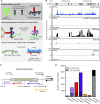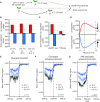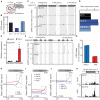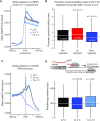Native elongation transcript sequencing reveals temperature dependent dynamics of nascent RNAPII transcription in Arabidopsis
- PMID: 31863587
- PMCID: PMC7049701
- DOI: 10.1093/nar/gkz1189
Native elongation transcript sequencing reveals temperature dependent dynamics of nascent RNAPII transcription in Arabidopsis
Abstract
Temperature profoundly affects the kinetics of biochemical reactions, yet how large molecular complexes such as the transcription machinery accommodate changing temperatures to maintain cellular function is poorly understood. Here, we developed plant native elongating transcripts sequencing (plaNET-seq) to profile genome-wide nascent RNA polymerase II (RNAPII) transcription during the cold-response of Arabidopsis thaliana with single-nucleotide resolution. Combined with temporal resolution, these data revealed transient genome-wide reprogramming of nascent RNAPII transcription during cold, including characteristics of RNAPII elongation and thousands of non-coding transcripts connected to gene expression. Our results suggest a role for promoter-proximal RNAPII stalling in predisposing genes for transcriptional activation during plant-environment interactions. At gene 3'-ends, cold initially facilitated transcriptional termination by limiting the distance of read-through transcription. Within gene bodies, cold reduced the kinetics of co-transcriptional splicing leading to increased intragenic stalling. Our data resolved multiple distinct mechanisms by which temperature transiently altered the dynamics of nascent RNAPII transcription and associated RNA processing, illustrating potential biotechnological solutions and future focus areas to promote food security in the context of a changing climate.
© The Author(s) 2019. Published by Oxford University Press on behalf of Nucleic Acids Research.
Figures







Similar articles
-
Transcript isoform sequencing reveals widespread promoter-proximal transcriptional termination in Arabidopsis.Nat Commun. 2020 May 22;11(1):2589. doi: 10.1038/s41467-020-16390-7. Nat Commun. 2020. PMID: 32444691 Free PMC article.
-
The plant RNA polymerase II elongation complex: A hub coordinating transcript elongation and mRNA processing.Transcription. 2018;9(2):117-122. doi: 10.1080/21541264.2017.1356902. Epub 2017 Oct 4. Transcription. 2018. PMID: 28886274 Free PMC article.
-
TFIIS Is Crucial During Early Transcript Elongation for Transcriptional Reprogramming in Response to Heat Stress.J Mol Biol. 2023 Jan 30;435(2):167917. doi: 10.1016/j.jmb.2022.167917. Epub 2022 Dec 9. J Mol Biol. 2023. PMID: 36502880
-
Transcript elongation by RNA polymerase II in plants: factors, regulation and impact on gene expression.Plant J. 2024 May;118(3):645-656. doi: 10.1111/tpj.16115. Epub 2023 Feb 12. Plant J. 2024. PMID: 36703573 Review.
-
A G(enomic)P(ositioning)S(ystem) for Plant RNAPII Transcription.Trends Plant Sci. 2020 Aug;25(8):744-764. doi: 10.1016/j.tplants.2020.03.005. Epub 2020 Apr 11. Trends Plant Sci. 2020. PMID: 32673579 Review.
Cited by
-
Plant terminators: the unsung heroes of gene expression.J Exp Bot. 2023 Apr 9;74(7):2239-2250. doi: 10.1093/jxb/erac467. J Exp Bot. 2023. PMID: 36477559 Free PMC article. Review.
-
The non-coding RNA SVALKA locus produces a cis-natural antisense transcript that negatively regulates the expression of CBF1 and biomass production at normal temperatures.Plant Commun. 2023 Jul 10;4(4):100551. doi: 10.1016/j.xplc.2023.100551. Epub 2023 Jan 21. Plant Commun. 2023. PMID: 36681861 Free PMC article.
-
Exitrons: offering new roles to retained introns-the novel regulators of protein diversity and utility.AoB Plants. 2024 Mar 20;16(2):plae014. doi: 10.1093/aobpla/plae014. eCollection 2024 Feb. AoB Plants. 2024. PMID: 38566894 Free PMC article. Review.
-
RNA polymerase II speed: a key player in controlling and adapting transcriptome composition.EMBO J. 2021 Aug 2;40(15):e105740. doi: 10.15252/embj.2020105740. Epub 2021 Jul 13. EMBO J. 2021. PMID: 34254686 Free PMC article. Review.
-
A simple and robust method for isolating and analyzing chromatin-bound RNAs in Arabidopsis.Plant Methods. 2022 Dec 12;18(1):135. doi: 10.1186/s13007-022-00967-y. Plant Methods. 2022. PMID: 36510301 Free PMC article.
References
-
- Markovskaya E.F., Shibaeva T.G.. Low temperature sensors in plants: hypotheses and assumptions. Biol. Bull. 2017; 44:150–158.
-
- Thomashow M.F. PLANT COLD ACCLIMATION: freezing tolerance genes and regulatory mechanisms. Annu. Rev. Plant Physiol. Plant Mol. Biol. 1999; 50:571–599. - PubMed
Publication types
MeSH terms
Substances
LinkOut - more resources
Full Text Sources
Molecular Biology Databases

